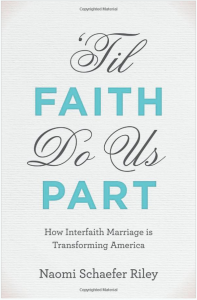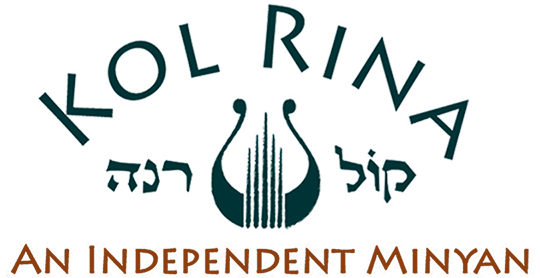 Some friends have come to me in recent years saying (in one version or another), “I tried my best. I raised my child with the best Jewish education I could afford. But my child went out into the world, fell in love with whoever he-or-she fell in love with, and being Jewish didn’t seem to play much of a part in it. What could I have done differently?”
Some friends have come to me in recent years saying (in one version or another), “I tried my best. I raised my child with the best Jewish education I could afford. But my child went out into the world, fell in love with whoever he-or-she fell in love with, and being Jewish didn’t seem to play much of a part in it. What could I have done differently?”
I have at least one kind of consolation to give today, as we read about the families of Abraham and Sarah, of Hagar and Ishmael, and Keturah, and are reminded of the other stories in the same book of Isaac and Rebekah, Jacob and Esau, and all the others. It turns out that our problems are not new problems.
Would it surprise you to know that the Torah records the names of eight sons of Abraham, and of these, only one—Isaac—followed in his father’s religious path? Yet Abraham is a paragon of faith and prime exemplar for us all. He did the best he could, and then left the rest to nature—or to God. Maybe that is the best any of us can do.
 I have just been reading a book, “Til Faith Do Us Part,” by Naomi Schaefer Riley, with the subtitle: “How Interfaith Marriage Is Transforming America.” Yes, there has been a transformation, working its way over the past 60 or so years. Back then, it seems that America was comprised of hermetically sealed ethnic and religious communities. But with the maturation of the American multi-ethnic melting pot, young people today see nearly everyone they come into contact as potential mates. It isn’t just Jews; the mainline Protestants, the evangelicals, the Catholics, the Moslems—all of them are experiencing this transformation and are looking for ways to adapt to it, all of which she reports.
I have just been reading a book, “Til Faith Do Us Part,” by Naomi Schaefer Riley, with the subtitle: “How Interfaith Marriage Is Transforming America.” Yes, there has been a transformation, working its way over the past 60 or so years. Back then, it seems that America was comprised of hermetically sealed ethnic and religious communities. But with the maturation of the American multi-ethnic melting pot, young people today see nearly everyone they come into contact as potential mates. It isn’t just Jews; the mainline Protestants, the evangelicals, the Catholics, the Moslems—all of them are experiencing this transformation and are looking for ways to adapt to it, all of which she reports.
There are so many flavors of people from Jewish and other religious backgrounds described in the book, and so many flavors of intermarriage. There is the Catholic-Jewish couple where the children are raised all Catholic or all Jewish—that’s the simplest case. Or the couple that decides to raise the children in both religions, or in no religion. Or the Sikh and the Hindu, both from India, but with a religious divide between them. Or the Moslem Egyptian tourguide who met the pretty Israeli travel agent in Sinai and they came to America to find a more accepting environment than back home. Or the interfaith couple that both convert together to a third religion—it could be Unitarianism, but could also be evangelical Christianity. Then there’s the couple that started out together in the same religion, but one of them “finds religion” somewhere else mid-course, so that what started as a same-faith marriage ended up an intermarriage.
As I was going back and forth between these descriptions and the narratives of the patriarchs and the matriarchs, I started seeing the Biblical narratives in a new light. Nearly all the patterns that Naomi Schaefer Riley describes can be found in some Biblical family or other. There is very little new under the sun. But sometimes you have to peel away the pious veneer of our traditional reading of these stories to see a more complex reality beneath the surface.
Let’s start with the story in today’s [First Day of Rosh Hashanah] Torah reading. We read: “Sarah saw the son whom Hagar the Egyptian had borne to Abraham, playing.” (Gen 21:9). The Hebrew word is metzachek. We find this word in a number of other contexts in the Torah. In the story of Isaac and Rebekah, we read that when they were in the land of the Philistines, Isaac spread word that Rebekah was his sister. But when they saw Isaac metzachek with Rebekah, they said, Come on now, she’s not your sister, she’s obviously your wife! (Gen 26:8-9) Later on, when the Israelites made the Golden Calf, they got up l’tzachek in front of it (Ex 32:6), whereupon God told Moses to look down and see that the people were totally out of control. So whatever Ishmael was doing with Isaac by way of metzachek was not mere innocent playing, but something of a nature that Sarah—apparently with no need for further explanation by the Biblical narrator—saw as sufficient justification to expel both Ishmael and Hagar from the family. Under today’s family law, it probably would come under the heading of “abuse.” Whatever it was, it was incompatible with remaining under Abraham’s tent.
We have the testimony of the Torah that Ishmael was by nature a kind of person not compatible with Abraham’s covenant with God: “He shall be a wild ass of a man—His hand against everyone, and everyone’s hand against him.” (Gen 16:12) The Torah tells us a number of other things about Ishmael: his mother Hagar was an Egyptian, and she got him an Egyptian wife after they were expelled from Abraham’s household. (Gen 16:1, 21:21) Ishmael had twelve sons, like Jacob. (Gen 25:12-15) On the positive side, Ishmael showed filial affection for Abraham, for when Abraham died, Ishmael and Isaac buried their father together. (Gen 25:9) We are not told if Ishmael had a spiritual relation with God, but his mother Hagar did. An angel appeared to her the first time she was thrown out of the house by Sarah, and showed her a well, which she called Be’er La-hai Ro’I, the Well of the Living One who Sees Me. (Gen 16:13) Maybe not by chance, Isaac settled at Be’er La-hai Ro’I after Abraham’s death. (Gen 24:62, 25:11)
So I think it makes very good sense to say that Hagar and Ishmael were not without spirituality, but they had a different kind of spirituality than Abraham. It would be only slightly anachronistic to say that theirs was a religiously mixed marriage that failed for a number of complex reasons, of which religious incompatibility was one.
We read further on, in Chapter 25 of Genesis, that Abraham took another wife, named Keturah, and had six sons by her, one of whose names—Midian—becomes significant in later Biblical history. He gave them all gifts and sent them to the East while he was still alive, so that only Isaac would be the true heir, both of his property and of the covenant with God. Now, the Rabbis of the Midrash were not content to let Keturah remain an otherwise-unknown personality, so they said that Keturah was really Hagar, come back for another spell as Abraham’s concubine after Sarah’s death. Whether you accept this explanation or not, it remains the case that his roaming eye persisted to a ripe old age. Moreover, by the Bible’s account, Abraham was a spectacular failure in passing on his spiritual heritage to his children—it took in only one out of eight.
Let’s move on to the next generation. We read that Abraham was extremely concerned that Isaac not marry one of the Canaanite women in the vicinity, so he sent back his servant (who traditionally was Eliezer though in the Biblical text he is nameless) back to his home country to pick out a cousin, Rebekah, as Isaac’s mate. (Gen Chapter 24) It sounds very much like our contemporary concern to marry within the fold. The Canaanite women were certainly not Jewish. But was Rebekah “Jewish” (quote-unquote)? Maybe half. Remember, Terah worshiped idols, and he was the father of both Abraham and Nahor. (Gen 11:27) Of these, only Abraham heeded the call of God Almighty, together with his nephew Lot, who was the son of a third brother Haran. (Gen 11:27, 12:4) There is evidence down the road that the family descended from Nahor—including Bethuel, Laban, and Rebekah—still maintained some form of idol-worship. So Rebekah came from the “less-Jewish” branch of the family (anachronistically speaking) and bringing her into the family was an informal way of converting her to Judaism.
Rebekah conceived and gave birth to twins, Esau and Jacob. Esau was a hairy man, a hunter; Jacob was smooth-skinned, and dwelt in tents. (Gen 25:25-28) To say it in Yiddish, Esau was the goy in the family, and Jacob was the Yid. But we also read that Isaac loved Esau more, and Rebekah loved Jacob more. A reversal of what you would expect. What is going on here? Again, we have to peel back the layers of traditional pious interpretation and look underneath. The tradition depicts Isaac as so devoted to God that he never resisted when the knife was put to his throat in tomorrow’s Torah reading, when he was bound on the altar. But a lot of his subsequent behavior can be explained in terms of post-traumatic stress syndrome with maybe a little passive-aggressive behavior thrown in. Isaac, who was brought up all-too-Jewish, to the point it almost killed him, is showing a desire to live out non-covenantal fantasies vicariously through his wild, earthy son Esau, while Rebekah, who was brought in as a half-outsider, has become super-loyal to her adopted religion, fiercely defending the interests of Jacob, who represents the Jewish future in the family. It is a role reversal that we see time and again among today’s intermarried couples, and makes for complicated family politics.
I will mention briefly a few other examples to fill out the picture. There is Rachel, who though she was Jacob’s favorite wife, turns out to have stolen her father’s idols on the way out from Aram, so she was not 100% pure in her monotheistic fidelity. (Gen 31:19, 29-35) There is Tamar, Judah’s daughter-in-law who becomes mother to two tribal families, from one of which the Davidic dynasty is descended. (Gen Chapter 38) She wasn’t even half-Jewish, but a full-blooded Canaanite woman (apparently by that time, there weren’t enough girl-cousins back in Mesopotamia to keep sending back for them), who in the story ends up more “righteous” than Judah, the born Jew. (Gen 38:26) Of course, there is Ruth, the Moabite woman who befriends Naomi and is also an ancestress of the Davidic line. There is Zipporah, the Midianite woman whom Moses marries, and who saves his life by circumcising their son. (Ex 4:24-26) On the other side of the ledger, there is the case of Samson, who married more than one Philistine woman, with ultimately disastrous results. (Ju 14:1-20, 16:4-21)
Back to Naomi Schaefer Riley’s book, “Til Faith Do Us Part.” Overall, I recommend the book, especially for the sober view it gives of the difficulties that come up in trying to create a religious family life within an intermarried setting. To her credit, in her own life she at least tried to anticipate these problems at the outset. When Naomi went out on her first date with the black Jehovah’s Witness man who later became her husband, she said that one thing he should know about her was that if she had children, they would be raised Jewish. He kept his word on that. But it still didn’t totally alleviate the problem that he was absent from the picture when she tried to give them a Jewish religious upbringing all by herself.
One of the things that Ms. Schaefer-Riley deplores in a lot of the intermarried couples whom she surveyed for the book is that at least half of them made no plans for what religious education they would give their children until after they were married. She quotes an evangelical pastor, David Slagle, who says, “Young people today are intentional about their education their career, thinking through the possibilities for an occupation and where they want to live and buying a home.” But when it comes to falling in love and choosing a life-partner, “our romantic view of marriage precludes intentionality.”
This comment, I think, cuts to the essence of the problem. We are all of us occupied with creating the narratives of our lives, whether we think about it that way or not. But unless we do so with intentionality, it may just happen, with haphazard results. When we select our mates to settle down with, if we don’t have the larger picture in mind, we tend to get caught up in the passion of the present and not think ahead to the full end of the story whose foundations we are laying.
One of the biggest gifts that the Jewish tradition gives us is a sense of participation in an ongoing narrative that unfolds on many levels. On the most basic level, there is the narrative of our own individual lives. But we are more than individuals; we belong to families, and as individuals we carry on the narratives of our families, while our families provide us with models for our own life-narratives.
On yet a higher level is the notion of covenant. A marriage is a covenant, and a religion is a covenant, and this is no accident. By entering into a covenant, we become a part of a reality larger than ourselves, while we enlarge our selves in the process.
Covenant is one of the key concepts in the patriarchal narratives we read on this holiday. The continuity of Judaism depended then, and depends now, on finding those individuals who will pledge themselves to uphold the covenant. The whole drama centers on who acts to further the covenant, and who wanders off in a different direction?
So as we prepare to write the next chapters in our lives, let us take the long view. Let us think hard about what choices we need to make, to lay the foundations for the rest of our lives. Let us write the stories of our lives that we can be proud of looking back on, to give our children and grandchildren the richness of legacy that forms a bridge between the present hour and eternity.

